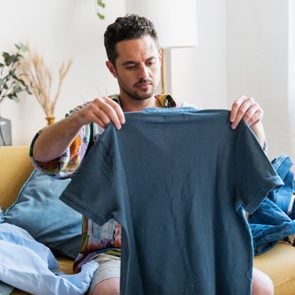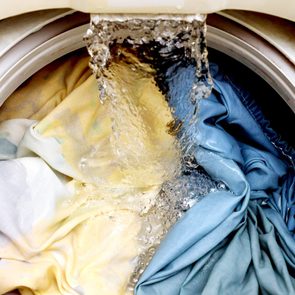How to Wash Microfiber Cloths to Preserve Their Cleaning Power
Updated: Apr. 19, 2024
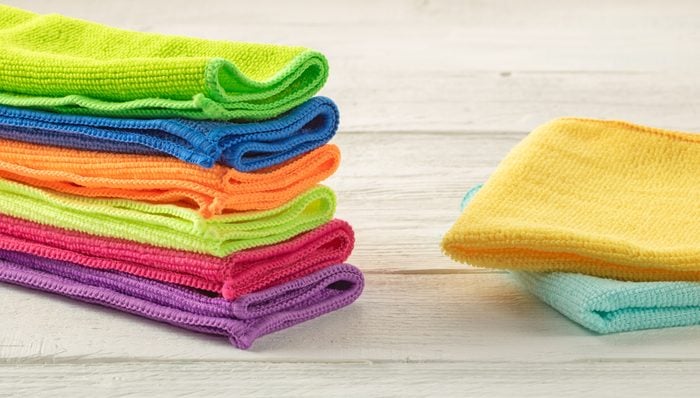
Keeping microfiber towels absorbent and debris-free requires specific laundering. Here's how to wash microfiber towels and extend their lifespan, according to experts.
Once you start mopping, swiping and wiping with microfiber cloths, you’ll never go back. These handy little cleaning tools are not only remarkably effective and popular with cleaning pros everywhere, they’re also reusable and incredibly long-lasting. But their longevity is largely dependent upon how well they’re maintained. To keep these fibers strong, durable and debris-free, you’ll need to know how to wash microfiber towels properly. (Doing so incorrectly could be lessening the effectiveness with each laundry cycle.)
That’s why we consulted fabric-care and laundry experts Patric Richardson, host of The Laundry Guy on HGTV and Discovery+, and Jennifer Druckamiller, director of product experience at Norwex, manufacturers of microfiber cloths, to explain how to do laundry when microfiber cloths are part of the load. They explain the step-by-step ins and outs as only experts can, so you can start fresh every cleaning session.
Get Reader’s Digest’s Read Up newsletter for more cleaning, humor, travel, tech and fun facts all week long.
About the experts
Reviewed for accuracy by: Mary Marlowe Leverette, a highly regarded fabric-care, stain-removal and housekeeping expert with more than 40 years of experience. |
What are microfiber towels?
As the name suggests, microfiber cloths are made from very small synthetic fibers woven to be both strong and long-lasting. Microfiber towels have been around since the 1950s but became more popular recently for cleaning after a study published in the American Journal of Infection Control found that microfiber cleaning cloths dampened with water removed up to 98% of bacteria and 93% of viruses from a surface, even without cleansers or disinfectant sprays. (Compare that with just 30% of bacteria and 23% of viruses removed by cotton fiber cloths.)
Unlike cotton or nylon cloths, which have large fibers, microfiber cloths have thousands of tiny fibers—200,000 in one square inch of a cloth, to be exact. When you’re cleaning, all those minuscule fibers pick up and hold dirt, dust and liquid. And because microfiber cloths are also positively charged (and the dirt and dust that sit on surfaces in your home are negatively charged), they can attract and hold debris like a magnet until rinsed out.
But those same qualities that make microfiber such an asset for cleaning can work against it during wash cycles. Unlike washing cotton bath towels, microfiber tends to attract chemical residues from detergents, lint from other towels, dirt and other articles, which is why knowing how to wash microfiber towels is key.
How to machine-wash microfiber towels
The No. 1 rule when washing microfiber cloths is to separate your laundry. Keeping microfiber fabric away from other towels or clothing items is vital. “When it’s time to launder, wash microfiber cloths separately or with other lint-free items (microfiber is designed to grab and hold onto lint),” says Druckamiller. And skip the harsh and scented detergents, which can coat the fibers of the cloth, reducing the amount of charge and, in turn, making it less effective, she says.
Richardson prefers to use vinegar or laundry soap over commercial detergent when washing microfiber cloths because harsh detergents tend to stick to the fibers, which then reduces their ability to pick up dirt and bacteria. “If you put microfiber cloths in a regular load of laundry, the detergent will not rinse away,” he says. And the next time you try to clean with it, he says, it will be like trying to clean with “a towel coated in butter.”
Mary Marlowe Leverette, fabric-care expert, adds, “Avoid the use of chlorine bleach in the wash, because it can damage microfiber. And never add fabric softeners or conditioners, because the residue that leaves the cloth feeling soft will clog the fibers and make it less effective as a cleaning tool.”
Supplies you’ll need
- White vinegar
- Or ammonia
- Or laundry soap
Directions
- Wipe down the interior of your washing machine with white vinegar if you regularly use laundry detergent. This step is to remove any detergent residue that can be left behind in the machine. (Microfiber is sensitive, and even a small amount of suds can affect its ability to clean.)
- Separate microfiber towels from all other laundry—they should be in their own load.
- Shake out the dirty microfiber cloths, either outside or over a trash bin, to get rid of excess dirt and debris. Then place them in the washing machine.
- Add white vinegar, ammonia or laundry soap (not detergent—the box will specify “laundry soap”), according to the package or machine instructions.
- Wash on the express warm cycle (do not wash with high heat). If you use commercial laundry detergent regularly, you may want to repeat the rinse cycle.
How to hand-wash microfiber towels
Hand-washing allows you to be selective about which fabrics you wash together, which makes this method ideal for microfiber towels. It also allows you to be specific about which laundry supplies make their way onto the microfiber. If you regularly use commercial laundry detergents that are prone to leaving residue in your washing machine, you may prefer this approach, says Richardson.
Supplies you’ll need
- Bucket
- White vinegar
- Water
Directions
- Shake out the dirty microfiber cloths, either outside or over a trash bin, to get rid of excess dirt and debris.
- In a clean bucket (preferably one you only use for this purpose, says Richardson), combine equal parts white vinegar and warm water. Add the microfiber cloths, making sure they are fully submerged in the solution. Swirl them around, then let them sit for 10 to 15 minutes.
- Wring the cloths out, empty the bucket and refill it with plain warm water.
- Submerge the microfiber cloths in the water to rinse. Empty the bucket and repeat until they’re fully rinsed.
How to dry microfiber towels
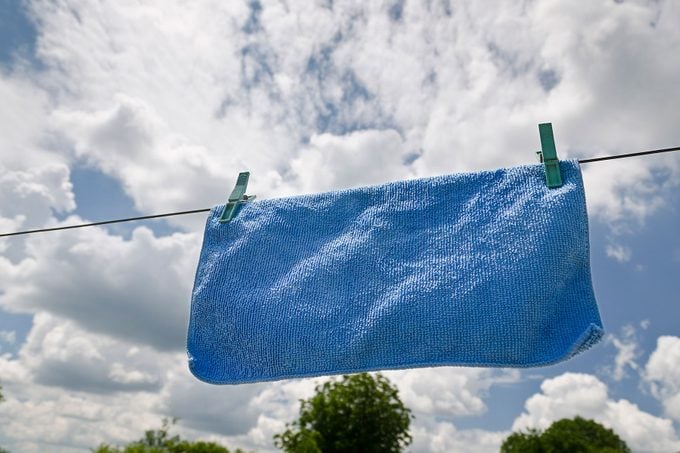
Washing microfiber cloths is only half the battle. How you dry the microfiber towel is equally important when it comes to maintaining its charge and keeping it lint-free. The ideal method, according to Druckamiller, is to hang microfiber cloths to dry outside in the sun or inside with good circulation. Avoid throwing them into the dryer, which reduces microfiber’s efficacy much faster, says Druckamiller. If you can’t avoid machine-drying, here are some tips for keeping your microfiber cloths in good condition while machine-drying.
Directions
- Give the lint trap a thorough cleaning to stop the microfiber from attracting unnecessary lint.
- Do not toss your microfiber cloths into the dryer with clothes or other towels. They will pick up the lint from other fabrics.
- Use a low heat setting. Too much heat will melt the fibers, says Druckamiller.
- Dry without using a dryer sheet or similar products. Even the best dryer sheets can clog up the fibers and make the towel less effective.
- Remove from the dryer as soon as the cycle finishes.
- Never iron.
Tips for maintaining microfiber towels
While proper washing will help maintain the efficacy of your microfiber towels, there are other steps you can take to keep them in tip-top shape.
- When cleaning with them, don’t use strong, chemical-based products. Surprisingly, microfiber cloths work best when used with just water.
- It’s fine to reuse microfiber cloths a few times before washing them, says Druckamiller. When they start to clean less effectively, or have overt dirt, grime or stains, it’s time to wash.
- If you want to avoid washing cloths after every use, give the towel a good shake and thorough rinse in the sink after a cleaning session.
- Keep all your microfiber towels together in one place, separate from other towels or laundry.
FAQs about microfiber towels
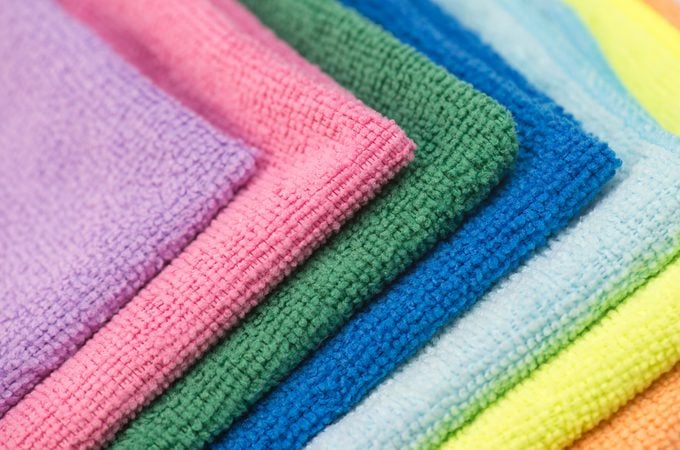
Can you wash and reuse microfiber towels?
Yes! This is one of the many glorious aspects of a microfiber towel. It is designed specifically to be washed and reused over and over again. That said, over time, the strength of the towel’s charge will lessen, and it’ll become less effective. Which is why maintenance improves the longevity. If you purchase a quality microfiber towel and care for it with the proper washing strategy, it should last you up to three solid years, or 150 washes, according to Druckamiller.
How will I know when to replace my microfiber towel?
In a nutshell, when your home doesn’t have that clean sparkle after a dusting session, it’s time to buy a new microfiber cloth. Stains, rough texture and fraying edges are all telltale signs that your microfiber cloth is wearing out and should be replaced soon.
Can you dry microfiber towels in the dryer?
Yes, but it is not recommended. Frequent drying will loosen fabric strands and make them prone to fabric pilling. If you do machine-dry, use a low heat setting and skip dryer sheets. While you’re at it, also learn what do dryer sheets do.
What is the best detergent for microfiber towels?
Microfiber is a hardy material and can tolerate more than 100 washes, but you can extend its life by using the right cleaner, research indicates. There are detergents created specifically for microfiber, such as the Chemical Guys Microfiber Wash Cleaning Detergent. But experts recommend a gentle laundry soap or white vinegar instead.
What temperature should you wash microfiber towels in?
Lukewarm water is best, and hot water should be avoided at all costs, as it can literally melt the fibers. In case that leaves you wondering, here is the best temperature to wash clothes to keep them looking brand new.
Is learning how to wash microfiber towels worth the bother?
Absolutely. If you take care of your microfiber towels, they will take care of you by keeping your home clean, environmentally friendly and cost-effective for years to come.
Why trust us
At Reader’s Digest, we’re committed to producing high-quality content by writers with expertise and experience in their field in consultation with relevant, qualified experts. For this piece, Kaitlin Clark tapped her experience covering laundry advice and clothing care, and then Mary Marlowe Leverette, a fabric-care, stain-removal and laundry expert with more than 40 years of industry experience, gave it a rigorous review to ensure that all information is accurate and offers the best possible advice to readers. We verify all facts and data, back them with credible sourcing and revisit them over time to ensure they remain accurate and up to date. Read more about our team, our contributors and our editorial policies.
Sources:
- Patric Richardson, host of The Laundry Guy on Discovery+ and author of Laundry Love and House Love; phone interview, Jan. 14, 2024
- Jennifer Druckamiller, director of product experience at microfiber company Norwex; interview, Sept. 2021
- EPA: “Using Microfiber Mops in Hospitals”
- American Journal of Infection Control: “Disinfection, sterilization, and antisepsis: An overview”


